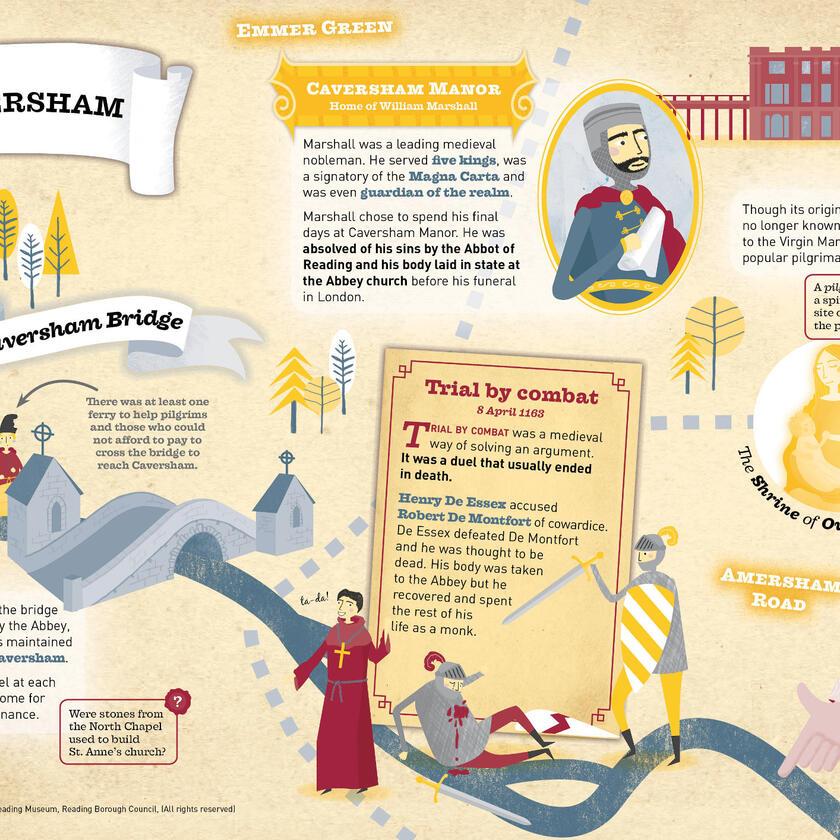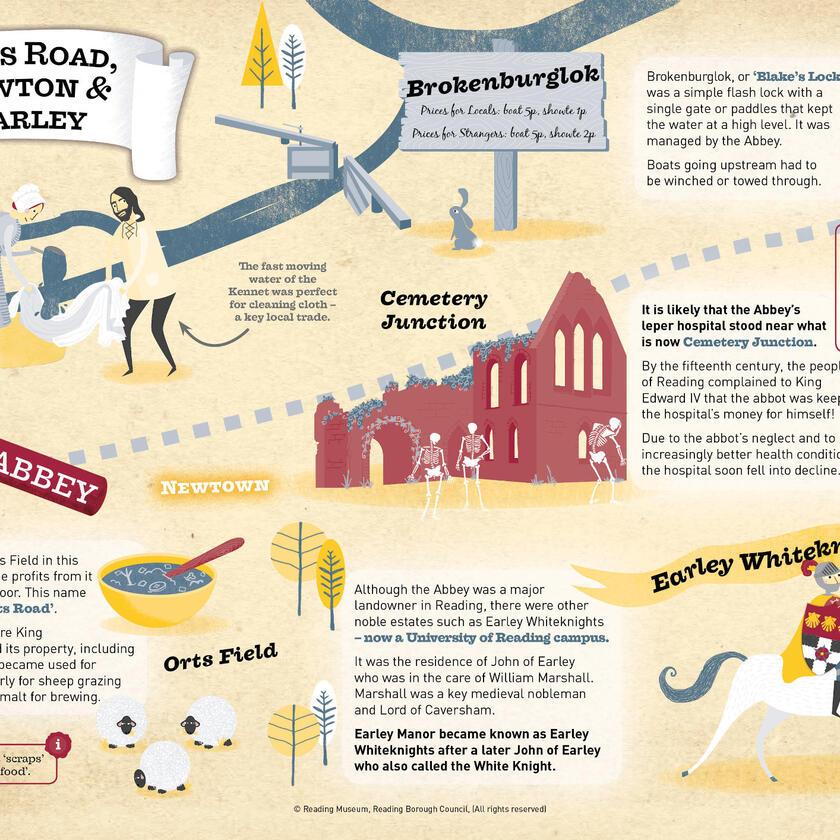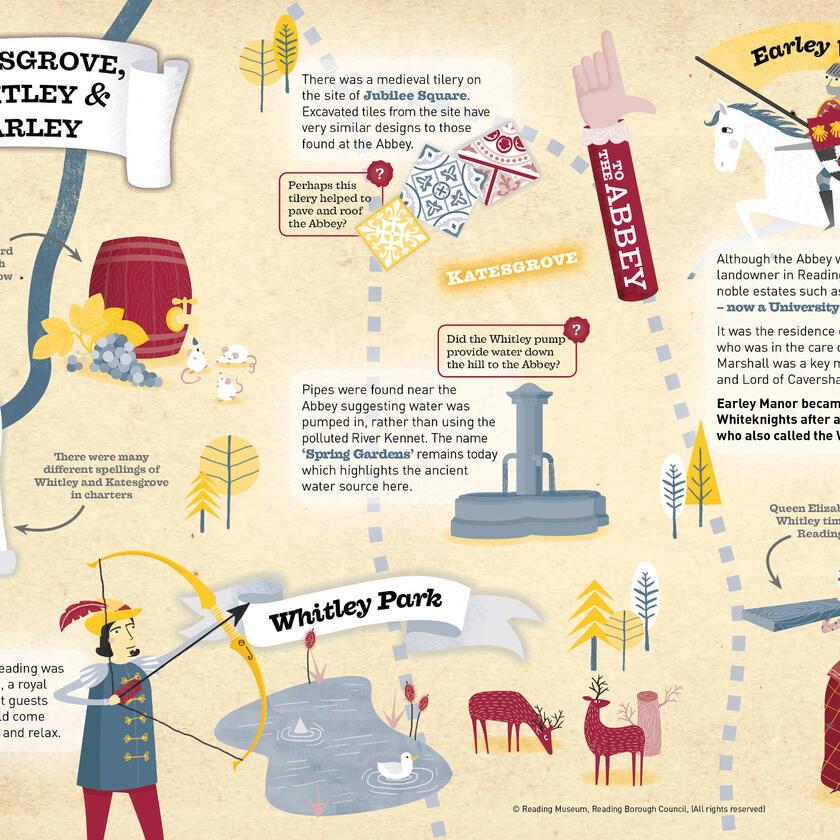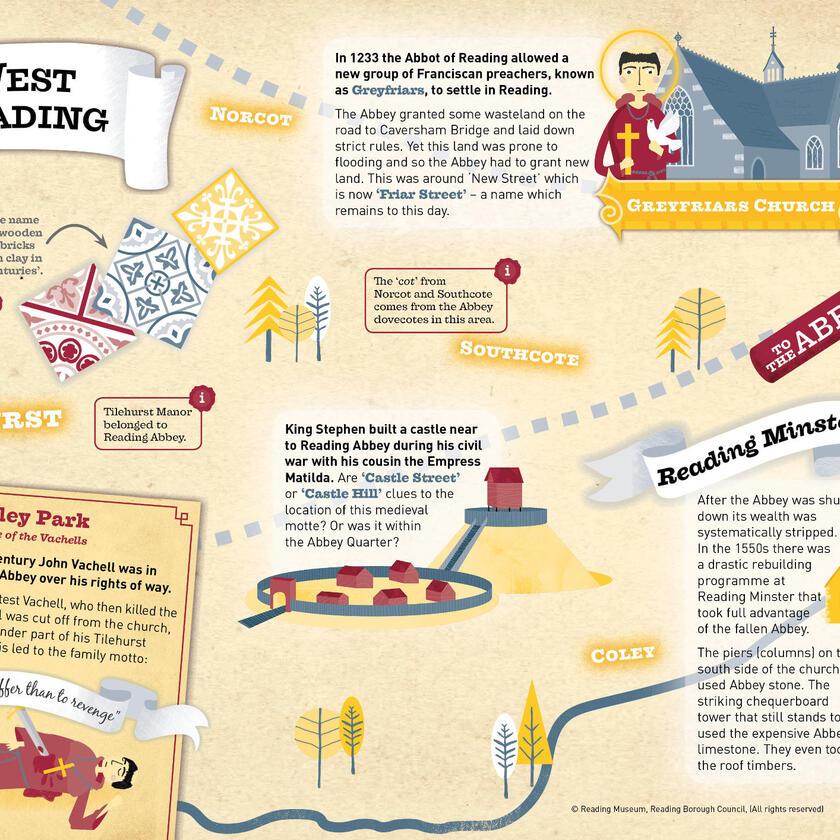The Medieval Abbey
A Royal Foundation
In medieval times, Reading was the site of a great royal Abbey – a religious community centred round a magnificent church - one of the largest monasteries in Europe. In 1121, King Henry I announced that he wanted to have a new abbey built at Reading. The Abbey would have a large and impressive church and living quarters for dozens of monks, who would worship in the church. No expense was spared in its construction. The Abbey Quarter covers the former precinct of this royal monastery.
He built this monastery between the rivers Kennet and Thames, in a place calculated for the reception of almost all who might have occasion to travel to the more populous cities of England.
- William of Malmesbury
William the Conqueror and 1066
The story of Reading Abbey started in 1066 when Henry's father William I, better know as William the Conqueror, invaded England and defeated his rival Harold, Earl of Wessex at the Battle of Hastings. William successfully founded the Norman dynasty and his son's William Rufus and Henry both followed him as kings of England. The invasion is famously depicted on the Bayeux Tapestry, and Reading Museum is home to a full-size Victorian version of the Tapestry that can be viewed online or its own dedicated museum gallery.

Harold is killed at the Battle of Hastings, as depicted on Reading Museum's Bayeux Tapestry
King Henry I is buried at his abbey
King Henry I died before his Abbey was complete and was buried here in 1136 in front of the high altar. The Abbey and the ground immediately outside became a desirable location for other royals and nobles to be buried.
Building work was still going on when the Abbey church was officially opened by the Archbishop of Canterbury, Thomas Becket, on 19 April 1164. The ceremony was attended by King Henry II (grandson of Henry I) and his noble followers. The opening ceremony dedicated the church to the Virgin Mary and St John the Evangelist.
The Abbey was the fourth largest church in Britain. It was such a large and ornate construction that building continued for almost 200 years after the original foundation in 1121. By this time the older parts of the Abbey would have been in need of repair! One of the most important additions was the Lady Chapel in 1314, dedicated to the Virgin Mary, at the east end of the church.
Monks lived, worked and worshipped here for more than 400 years. Royal funerals and weddings and meetings of court and Parliament were held at the Abbey. Thousands of pilgrims visited to pray for a blessing or a cure. It was a site of international significance.
The Abbey owned the town of Reading and the Abbot was its lord. The Abbey developed the town laying out new streets and properties including present-day Broad Street, Friar Street, London Street and Market Place.
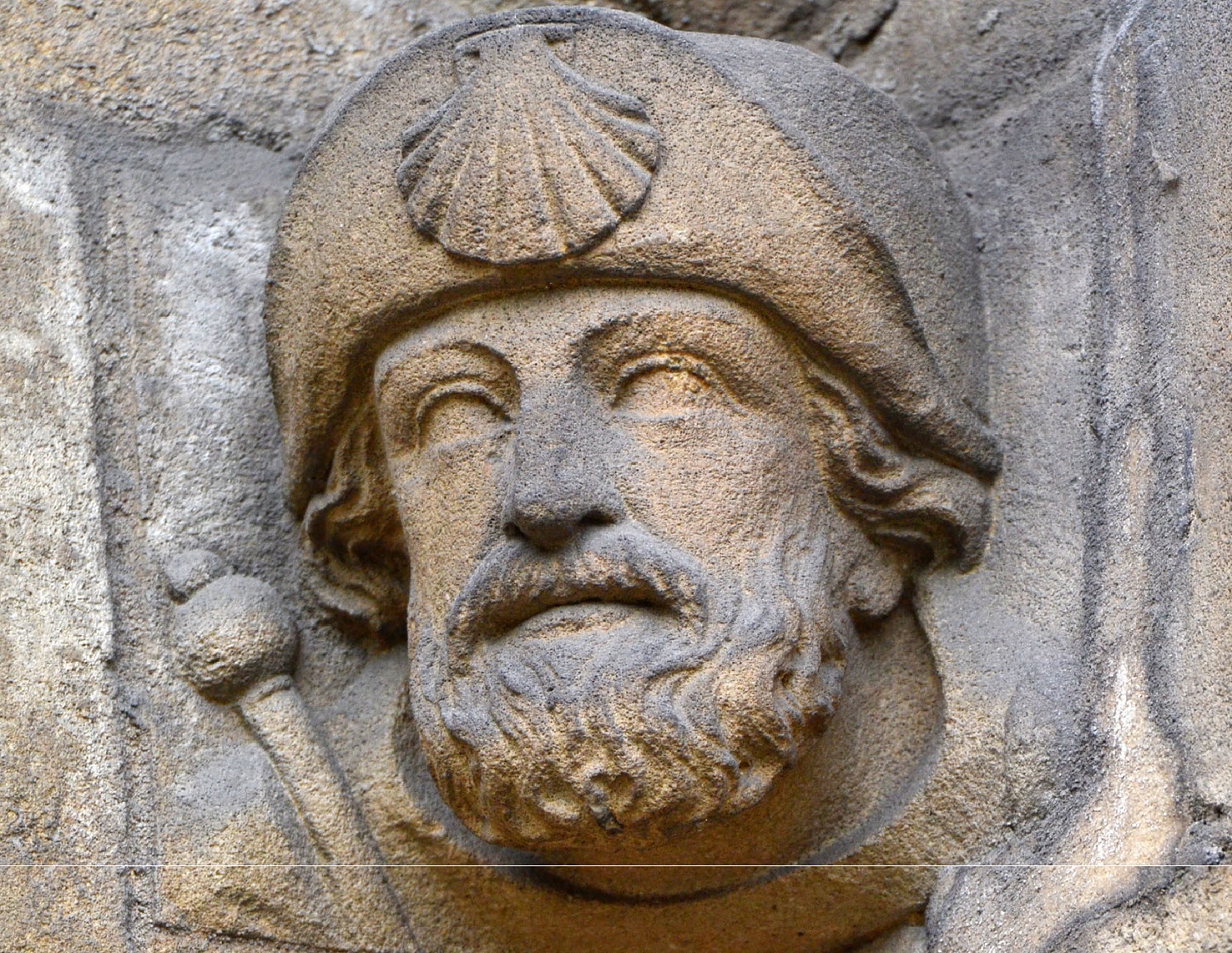
Pilgrim with a scallop shell of St James on the Abbey Gateway
Who was Henry I?
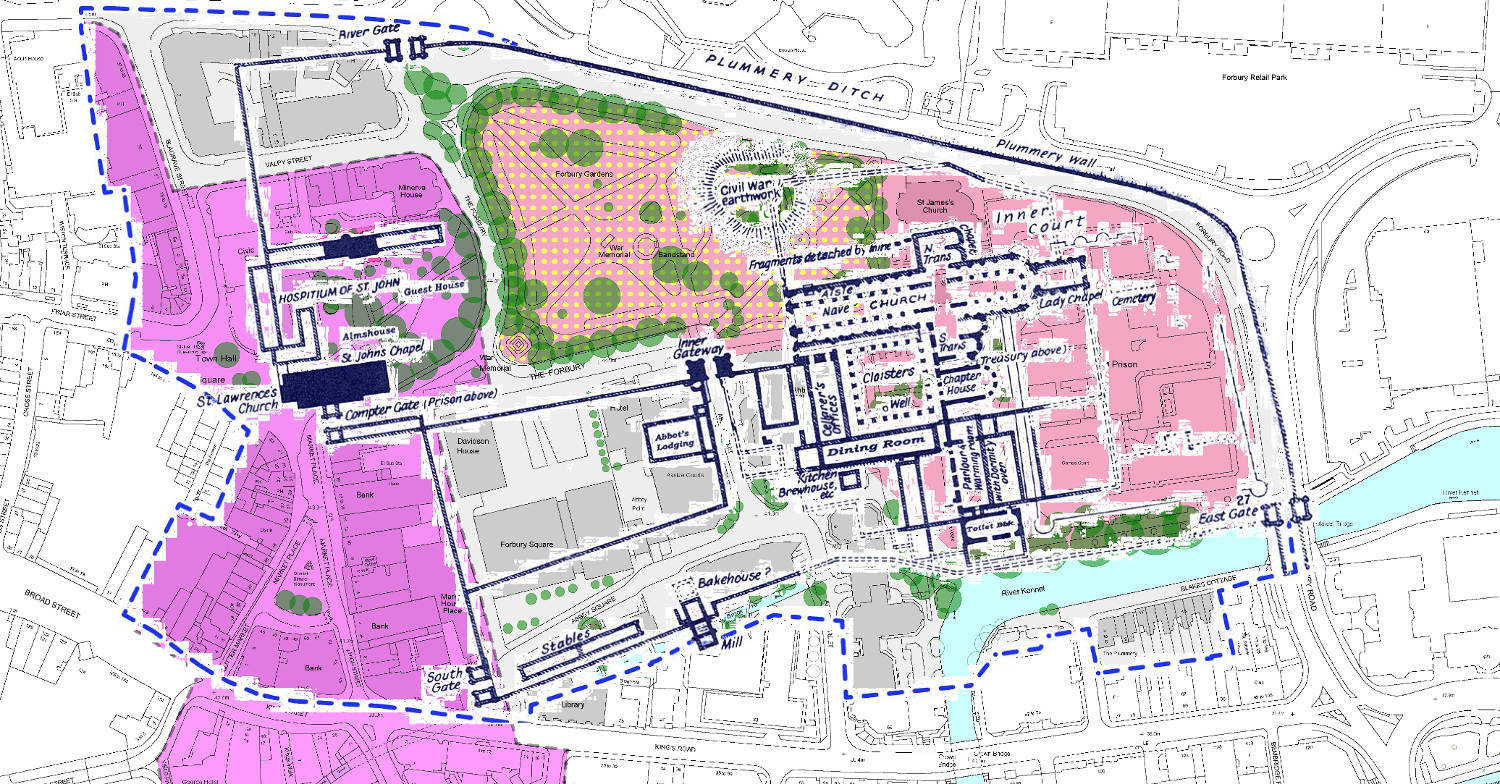
The plan of Reading Abbey overlaid on the modern street plan
The Elizabethan Palace
In 1539, over 400 years of monastic life at Reading Abbey suddenly came to an end. On the orders of King Henry VIII the Abbey was closed. Henry took the Abbey’s valuable possessions. The monks scattered. The abbot was executed.
The closure of Reading Abbey was not unique. Hundreds of abbeys were closed in England and Wales in the 1530s, as Henry declared himself as head of the church in England, and absorbed the wealth of the abbeys and priories into his own treasury. Historians call this closure the Dissolution.
The Abbey took on new uses. The abbot’s lodgings were converted into royal accommodation. This allowed the Abbey to remain a popular and convenient, royal lodging. Out of Henry VIII’s children, Elizabeth I was the most frequent visitor to Reading. Edward VI and Mary with her husband Prince Philip of Spain visited the palace only once. The Abbey Gateway became the entrance to this royal palace.
During Elizabeth’s reign, building repairs and improvements were made to the lodgings as well as the stables and St Laurence’s church. The Hospitium of St John, beside St Laurence’s church, where pilgrims had stayed, became the town hall and the boy's grammar school.
Royals sporadically stayed at the Abbey up until the Civil War.
The Civil War Fortification
Royalist Garrison
During the English Civil War in the seventeenth-century, supporters of parliament fought loyalists to the crown. Reading has always been a strategic position; it sits between London and Oxford, and on the rivers Thames and Kennet. This is likely to be why King Charles I based himself here in Reading for almost a month. Even after the King left for Oxford, Reading remained as a garrisoned outpost, protecting Charles I from forces coming from London.
The Siege of Reading
In April 1643, Parliamentary supporters laid siege to Reading. Defensive works were constructed across the Abbey Quarter. The Abbey ruins were a source of stone to build these defences, hastening their destruction. The large mound in the Forbury Gardens is all that remains of the extensive fortifications.
The Abbey was further destroyed after suffering from ten days of assault. The royalists surrendered. For the remainder of the Civil War, Reading changed sides numerous times. Apart from a few repairs paid for by King Charles II, royal involvement at Reading Abbey had ended.
The Ruins
Following the Civil War, the ownership of the Abbey Ruins was complicated and disputed. Private owners used the Abbey as they wished; a school was established in the chapter house and homes built up against the walls. Some owners chose to destroy any Abbey remains on their land to make way for new buildings.
St. James’ Roman Catholic Church was founded in 1837. It was designed by the Victorian architect A.W. N. Pugin. Abbey stones were used in its construction and its Romanesque architectural style gives a flavour of what the Abbey church once may have looked like.
The Gateway
The Abbey Gateway remained in use after the demolition of most of the other Abbey buildings. It was used as the school room of the Reading Ladies Boarding School which was famously attended by Jane Austen in 1785. In 1861 the Gateway collapsed in a gale, shortly after funds had been raised for vital conservation. Instead the Gate had to be substantially rebuilt. This work was completed by Sir George Gilbert Scott, a Victorian architect known for his Gothic Revival work. It was fully restored in 2017-2018.
The Gardens
In 1855, the Forbury (once the outer court of the Abbey) was acquired by the Council (then the Reading Corporation). It was then that the Forbury Gardens were laid out with formal flower beds, exotic trees and ornamental features re-using Abbey stones. Since the time of the Abbey, the Forbury has always been a space for the people of Reading.
The Maiwand Lion in the Forbury Gardens is an iconic part of the town’s identity. It was erected in 1886 to commemorate those from the Berkshire Regiment who died in the Battle of Maiwand in Afghanistan. The battle inspired Sir Arthur Conan Doyle to base his character, Doctor Watson, on the Regiment’s medical officer.
In the Second World War the Abbey Ruins resumed their defensive role, like they had done in the Civil War. An air-raid shelter was built in the dormitory for the children of St James’ school next to the Catholic Church.
The Gaol
The remains of the apse (the semi-circular end) and the lady chapel of the Abbey church were destroyed when a new County Gaol was built in 1786. This was mostly built over the site of the Abbey Infirmary (hospital). The current, cruciform structure was opened in 1844. Designed by William Bonython Moffat and George Gilbert Scott, who was also the architect of the Abbey Gateway restoration, it is a significant example of Victorian prison architecture.
Reading Gaol enforced the ‘separate system’ which ensured prisoners never saw, nor spoke to anyone. Oscar Wilde was famously imprisoned here between 1895 and 1897. His experiences led him to write The Ballad of Reading Gaol.
Throughout the twentieth century the prison became an internment centre for suspect spies, a wartime military detention centre and a borstal. In 1969 it was reopened as a local prison following substantial alterations to the site, most notably the replacement of the perimeter walls. The prison closed in September 2013.

The ruins of Reading Abbey with the Victorian prison in the background.
The Abbey Quarter
In 2009 the abbey ruins closed. This was after condition surveys highlighted that they were no longer safe to be open to the public.
In 2010 the Abbey Quarter was conceived to pull together a number of historic buildings and monuments in the Abbey’s former precinct into one co-ordinated approach. Conservation work of the Ruins and Gateway and the development of a new interpretation scheme started in February 2017 and the abbey reopened on 16 June 2018.
Read articles about the Abbey's history on the Reading Museum Blog

